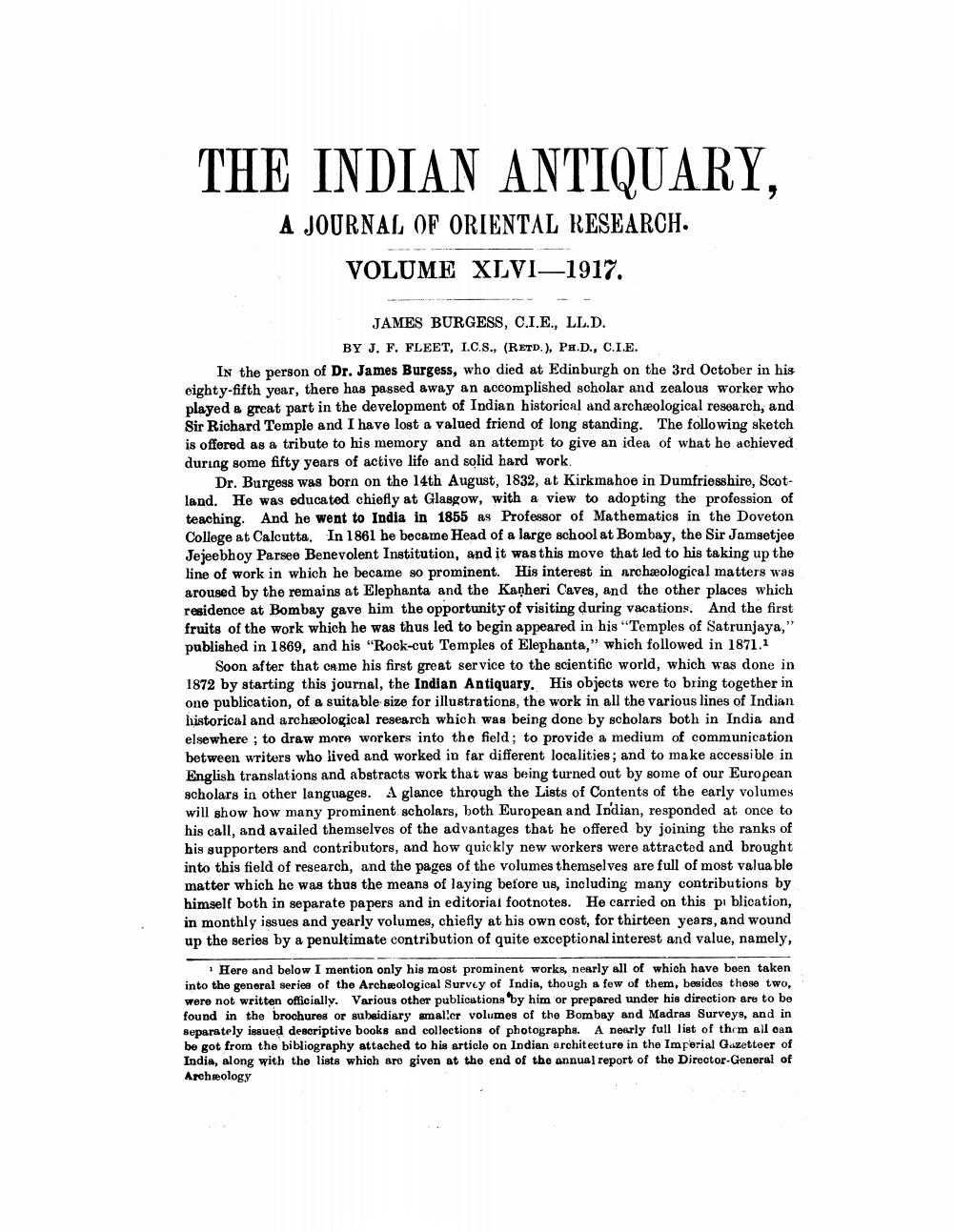________________
THE INDIAN ANTIQUARY.
A JOURNAL OF ORIENTAL RESEARCH.
VOLUME XLVI—1917.
JAMES BURGESS, C.I.E., LL.D.
BY J. F. FLEET, I.C.S., (RETD.), PH.D., C.L.E. In the person of Dr. James Burgess, who died at Edinburgh on the 3rd October in his eighty-fifth year, there has passed away an accomplished scholar and zealous worker who played a great part in the development of Indian historical and archæological research, and Sir Richard Temple and I have lost a valued friend of long standing. The following sketch is offered as a tribute to his memory and an attempt to give an idea of what he achieved during some fifty years of active life and solid hard work.
Dr. Burgess was born on the 14th August, 1832, at Kirkmahoe in Dumfriesshire, Scotland. He was educated chiefly at Glasgow, with a view to adopting the profession of teaching. And he went to India in 1855 as Professor of Mathematics in the Doveton College at Calcutta. In 1861 he became Head of a large school at Bombay, the Sir Jamsetjee Jejeebhoy Parsee Benevolent Institution, and it was this move that led to his taking up the line of work in which he became so prominent. His interest in archæological matters was aroused by the remains at Elephanta and the Kanheri Caves, and the other places which residence at Bombay gave him the opportunity of visiting during vacations. And the first fruits of the work which he was thus led to begin appeared in his "Temples of Satrunjaya," published in 1869, and his "Rock-cut Temples of Elephanta," which followed in 1871.1
Soon after that came his first great service to the scientific world, which was done in 1872 by starting this journal, the Indian Antiquary. His objects were to bring together in one publication, of a suitable size for illustrations, the work in all the various lines of Indian historical and archæological research which was being done by scholars both in India and elsewhere ; to draw more workers into the field; to provide a medium of communication between writers who lived and worked in far different localities, and to make accessible in English translations and abstracts work that was being turned out by some of our European scholars in other languages. A glance through the Lists of Contents of the early volumes will show how many prominent scholars, both European and Indian, responded at once to his call, and availed themselves of the advantages that he offered by joining the ranks of his supporters and contributors, and how quickly new workers were attracted and brought into this field of research, and the pages of the volumes themselves are full of most valuable matter which he was thus the means of laying before us, including many contributions by himself both in separate papers and in editorial footnotes. He carried on this publication, in monthly issues and yearly volumes, chiefly at his own cost, for thirteen years, and wound up the series by a penultimate contribution of quite exceptional interest and value, namely,
Here and below I mention only his most prominent works, nearly all of which have been taken into the general series of the Archeological Survey of India, though a few of them, besides these two, were not written officially. Various other publications by him or prepared under his direction are to be found in the brochures or subsidiary smaller volumes of the Bombay and Madras Surveys, and in separately issued descriptive books and collections of photographs. A nearly full list of them all can be got from the bibliography attached to his article on Indian architecture in the Imperial Gazetteer of India, along with the lists which are given at the end of the annual report of the Director-General of Archeology




